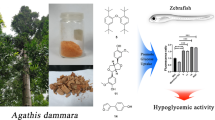Abstract
Royal jelly acid, 10-hydroxy-trans-2-decenoic acid (10H2DA), is a major lipid component of royal jelly, which is the exclusive diet of queen honeybees. Previously, we showed partial inhibition of lipopolysaccharide (LPS)-induced NF-κB activation by 10H2DA. In this study, the ability of 10H2DA to inhibit LPS-induced nitric oxide (NO) production was investigated. LPS-induced NO production and inducible NO synthase (iNOS) gene transcription were inhibited by 10H2DA. LPS-stimulated interferon (IFN)-β production, IFN regulatory factor-1 induction and IFN-stimulated response element activation, which are required for iNOS induction, were unaffected by 10H2DA. IFN-β-induced NO production, however, was significantly inhibited by 10H2DA. Furthermore, IFN-β-induced nuclear factor (NF)-κB activation and tumour necrosis factor (TNF)-α production were significantly inhibited by 10H2DA, and TNF-α-induced NF-κB activation was also inhibited by 10H2DA. These results and our previous study suggest that 10H2DA inhibits LPS- and IFN-β-induced NO production via inhibition of NF-κB activation induced by LPS or IFN-β.




Similar content being viewed by others
REFERENCES
Rembold, H. 1965. Biologically active substances in royal jelly. Vitamins and Hormones 23: 359–382.
Shuel, R., and S. Dixon. 1960. The early establishment of dimorphism in the female honeybee, Apis mellifera L. Insectes Sociaux 7: 265–282.
Kohno, K., I. Okamoto, O. Sano, N. Arai, K. Iwaki, M. Ikeda, and M. Kurimoto. 2004. Royal jelly inhibits the production of proinflammatory cytokines by activated macrophages. Bioscience, Biotechnology, and Biochemistry 68: 138–145.
Tamura, T., A. Fujii, and N. Kuboyama. 1987. Antitumor effects of royal jelly (RJ). Folia Pharmacologica Japonica 89: 73–80.
Helleu, C. 1956. Antibacterial properties of royal jelly; bactericidal and antibiotic effects of neutralized royal jelly. Annals of Institute Pasteur (Paris) 91: 231–237.
Lercker, G., P. Capella, L.S. Conte, F. Ruini, and G. Giordani. 1982. Components of royal jelly II. The lipid fraction, hydrocarbons and sterols. Journal of Apicultural Research 21: 178–184.
Townsend, G.F., J.F. Morgan, and B. Hazlett. 1959. Activity of 10-hydroxydecenoic acid from royal jelly against experimental leukaemia and ascitic tumours. Nature 183: 1270–1271.
Townsend, G.F., J.F. Morgan, S. Tolnai, B. Hazlett, H.J. Morton, and R.W. Shuel. 1960. Studies on the in vitro antitumor activity of fatty acids. I. 10-Hydroxy-2-decenoic acid from royal jelly. Cancer Research 20: 503–510.
Blum, M.S., A.F. Novak, and S. Taber 3rd. 1959. 10-Hydroxy-δ 2-decenoic acid, an antibiotic found in royal jelly. Science 130: 452–453.
Sugiyama, T., K. Takahashi, S. Tokoro, T. Gotou, P. Neri, and H. Mori. 2011. Inhibitory effect of 10-hydroxy-trans-2-decenoic acid on LPS-induced IL-6 production via reducing IκB-ζ expression. Innate Immunity 18: 429–437.
Takahashi, K., T. Sugiyama, S. Tokoro, P. Neri, and H. Mori. 2012. Inhibition of interferon-γ-induced nitric oxide production by 10-hydroxy-trans-2-decenoic acid through inhibition of interferon regulatory factor-8 induction. Cellular Immunology 273: 73–78.
Vila-del Sol, V., M.D. Diaz-Munoz, and M. Fresno. 2007. Requirement of tumor necrosis factor α and nuclear factor-κB in the induction by IFN-γ of inducible nitric oxide synthase in macrophages. Journal of Leukocyte Biology 81: 272–283.
Xie, Q.W., R. Whisnant, and C. Nathan. 1993. Promoter of the mouse gene encoding calcium-independent nitric oxide synthase confers inducibility by interferon γ and bacterial lipopolysaccharide. The Journal of Experimental Medicine 177: 1779–1784.
Kamijo, R., H. Harada, T. Matsuyama, M. Bosland, J. Gerecitano, D. Shapiro, J. Le, S.I. Koh, T. Kimura, S.J. Green, T.W. Mak, T. Taniguchi, and J. Vilcek. 1994. Requirement for transcription factor IRF-1 in NO synthase induction in macrophages. Science 263: 1612–1615.
Kim, Y.M., B.S. Lee, K.Y. Yi, and S.G. Paik. 1997. Upstream NF-κB site is required for the maximal expression of mouse inducible nitric oxide synthase gene in interferon-γ plus lipopolysaccharide-induced RAW 264.7 macrophages. Biochemical and Biophysical Research Communications 236: 655–660.
Martin, E., C. Nathan, and Q.W. Xie. 1994. Role of interferon regulatory factor 1 in induction of nitric oxide synthase. The Journal of Experimental Medicine 180: 977–984.
Ohmori, Y., and T.A. Hamilton. 2001. Requirement for STAT1 in LPS-induced gene expression in macrophages. Journal of Leukocyte Biology 69: 598–604.
Sugiyama, T., T. Gotou, K. Moriyama, N. Kajiura, T. Hasegawa, J. Tomida, K. Takahashi, T. Komatsu, H. Ueda, K. Sato, S. Tokoro, P. Neri, and H. Mori. 2012. Mechanism of inhibition of lipopolysaccharide-induced interferon-β production by 2-aminopurine. Molecular Immunology 52: 299–304.
Sugiyama, T., M. Fujita, N. Koide, I. Mori, T. Yoshida, H. Mori, and T. Yokochi. 2004. 2-Aminopurine inhibits lipopolysaccharide-induced nitric oxide production by preventing IFN-β production. Microbiology and Immunology 48: 957–963.
Green, L.C., D.A. Wagner, J. Glogowski, P.L. Skipper, J.S. Wishnok, and S.R. Tannenbaum. 1982. Analysis of nitrate, nitrite, and [15 N]nitrate in biological fluids. Analytical Biochemistry 126: 131–138.
McWhirter, S.M., K.A. Fitzgerald, J. Rosains, D.C. Rowe, D.T. Golenbock, and T. Maniatis. 2004. IFN-regulatory factor 3-dependent gene expression is defective in Tbk1-deficient mouse embryonic fibroblasts. Proceedings of the National Academy of Sciences of the United States of America 101: 233–238.
Yang, C.H., A. Murti, S.R. Pfeffer, J.G. Kim, D.B. Donner, and L.M. Pfeffer. 2001. Interferon α/β promotes cell survival by activating nuclear factor κB through phosphatidylinositol 3-kinase and Akt. The Journal of Biological Chemistry 276: 13756–13761.
Pahl, H.L. 1999. Activators and target genes of Rel/NF-κB transcription factors. Oncogene 18: 6853–6866.
Schafer, S.L., R. Lin, P.A. Moore, J. Hiscott, and P.M. Pitha. 1998. Regulation of type I interferon gene expression by interferon regulatory factor-3. The Journal of Biological Chemistry 273: 2714–2720.
Yamamoto, M., S. Yamazaki, S. Uematsu, S. Sato, H. Hemmi, K. Hoshino, T. Kaisho, H. Kuwata, O. Takeuchi, K. Takeshige, T. Saitoh, S. Yamaoka, N. Yamamoto, S. Yamamoto, T. Muta, K. Takeda, and S. Akira. 2004. Regulation of Toll/IL-1-receptor-mediated gene expression by the inducible nuclear protein IκBζ. Nature 430: 218–222.
Acknowledgments
This work was supported by a grant from the Japan Royal Jelly Fair Trade Council (Tokyo, Japan).
Conflict of Interest
The authors have no conflict of interest to declare.
Author information
Authors and Affiliations
Corresponding author
Rights and permissions
About this article
Cite this article
Sugiyama, T., Takahashi, K., Kuzumaki, A. et al. Inhibitory Mechanism of 10-Hydroxy-trans-2-decenoic Acid (Royal Jelly Acid) Against Lipopolysaccharide- and Interferon-β-Induced Nitric Oxide Production. Inflammation 36, 372–378 (2013). https://doi.org/10.1007/s10753-012-9556-0
Published:
Issue Date:
DOI: https://doi.org/10.1007/s10753-012-9556-0




